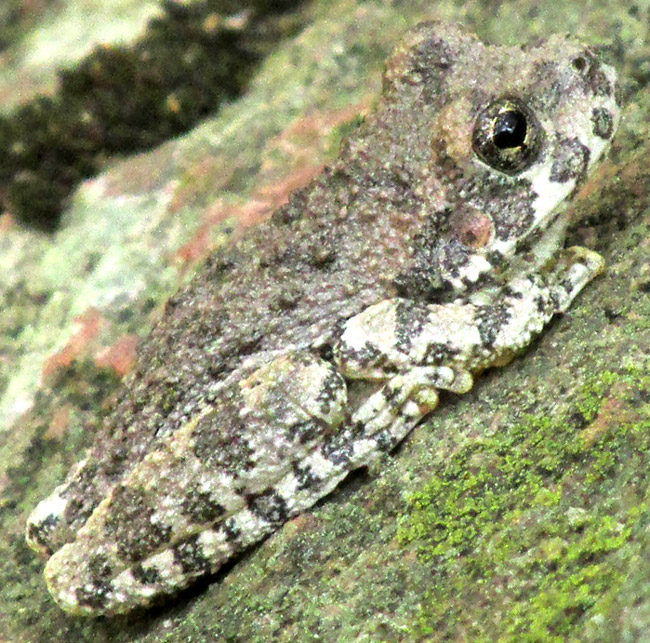Excerpts from Jim Conrad's
Naturalist Newsletter
Entry dated November 9, 2023, from notes taken near Cascadas de La Piedad waterfall 3kms NW of the community of San Pablo, municipality of Almeaco de Bonfil; in canyon of La Piedad below the falls; N20.1017°, W100.0041°, elevation 2360 meters (7750ft); extreme southern Querétaro state, MÉXICO
CANYON TREEFROG

In deep shade on a mossy rock at the canyon's bottom, the above Canyon Treefrog, HYLA ARENICOLOR, didn't seem too nervous about my getting close. His colors and patterning amid the rock's lichen splotches camouflaged him nicely; it was just good luck that I saw him at all.
He was so warty that at first I thought he was a toad, but he lacked bulging parotoid glands behind the eyes. He clung to the rock's vertical wall -- the above picture was skewed to avoid a long image -- like a treefrog. His toe tips were enlarged like a treefrog's, though not as strikingly as in some species. Spanish doesn't seem to have a regular word for "treefrog," so an image search was done on "ranas de Querétaro, the word rana just meaning frog. Pictures turned up matching our rock-clinger labeled HYLA ARENICOLOR, and ranita de las rocas, meaning "little frog of the rocks." In English we call the species Canyon Treefrog.
Canyon Treefrogs are widely distributed from dry parts of Utah and southern California, and sporadically across the US southeastern states, south through Mexico just barely to Oaxaca state in the south. They're described as inhabiting various environments in dry areas, including streambanks, but most often found in pools in canyon bottoms. Mostly they are ground dwellers, but can be found clinging to boulders and in trees. The AmphibiaWeb.Org page for the species lists the species' main threat as that of overcollection for the pet trade and by collectors. It's vulnerable because it's easily seen when basking on rocks.
As is expected of a good treefrog, Canyon Treefrogs feed on a variety of insects, including beetles, ants and caterpillars.
Canyon Treefrogs vary greatly in appearance, often being much darker than ours. I read that when exposed to sunlight, the top coloration changes from dark to light gray. Ours was in a well shaded spot, though it was much lighter than most pictures show them, so that's interesting. A feature visible in all the color variations is that a dark-edged light spot appears beneath each eye, not a dark bar running through it.Katy Klymus's 2011 dissertation at the University of Missouri entitled "Phylogenetic and Behavioral Differentiation in the Canyon Treefrog, Hyla arenicolor," documented significant geographical variation in the calls of male Canyon Treefrogs. She suggested that the differences potentially could lead to reproductive isolation among various populations, a condition which might eventually enable new taxa to arise. Her gene studies found no gene flow among the currently existing call-based distinct populations. She observed the greatest differences between northern and Mexican populations, and these differences "... have the potential to serve as effective behavioral isolating mechanisms." Her work presents a snapshot of evolution happening before our... ears.
Since our treefrog was on a rock in a canyon, both the Spanish and English names seem appropriate enough. However, taxonomically, the genus name has been debated. Our frog was first assigned to Hyla back in 1768, but in 2016 genetic studies showed that that genus, a big one incorporating over 300 species, was neatly divided between those whose genes were Old World, and those with New World genes. Our frog was shifted to the New World genus Dryophytes. But the go-to place for accepted frog binomials, AmphibiaWeb.Org, currently retains the earlier Hyla name, "thus stabilizing traditional taxonomy," they explain. Some accept that reasoning, others don't.